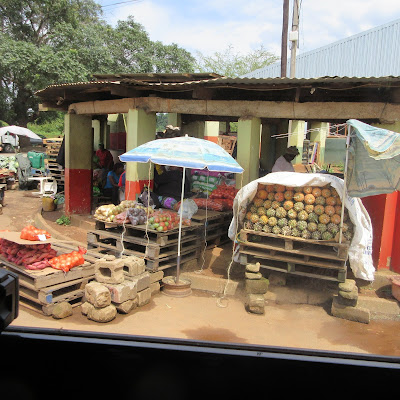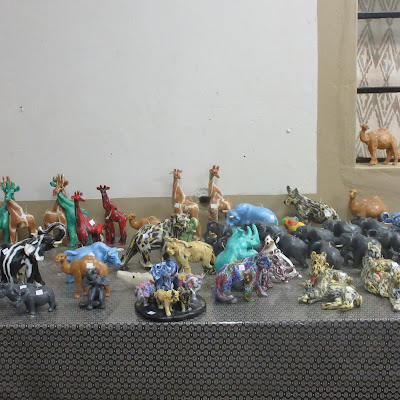We started our journey towards Kwazulu Natal. En route we saw Execution Rock.
This is the Nyonyane Mountain with its exposed granite peak. This is where ancient Bushmen once lived and where Swazi Royal graves are situated. A legend tells of how the mountain got its nickname of Execution Rock. Swazis suspected of witchcraft or criminals were forced to walk of the edge at spearpoint for their crimes!
All the group was intrigued by the number of cattle that wandered freely on the roads. Lutendo told us that if a cow causes an accident, the owner, if he is to be found, is expected to pay the cost. Usually the owner is not to be found. If the police are not about and the owner is not about it is not unusual for people in the area to cut the animal up for food.
This is the Parliament of Swaziland - Charlotte was in the way! Next to the Parliament is the National Museum where there is a replica of the grave of the first King of Swaziland.
This is Eludzidzini, the Queen Mother's residence and where the King comes when he is on retreat. The King of Swaziland is the Lion and the Queen Mother is the She Elephant.
The fence around the royal residence reflects the colours of the flag of Swaziland.
Representation of the King and Queen Mother!
By the end of our trip through Swaziland we had seen 4 homes of the king and, according to Lutendo, there are lots more.
Lutendo tells us that these tins with pipes attached are for colonic irrigation - it doesn't bear thinking about! We also saw similar tins , more the size of buckets, with leads attached and an electric plug - these were to heat water.
Fruit market - a much more natural and attractive prospect. The pineapples in this area are really sweet.
Our first stop of the day was at the Swazi Candle Factory where each candle is made and finished by hand using the age-old technique "millefiore". Millefiore means thousand flowers and was first used in Alexandria, and perfected in Venice and Murano and this factory is now a major tourist attraction in Swaziland.
Demonstration of how to make a colorful elephant candle.
Lots of colorful animal candles.
Jim and I had wandered off to look at what was for sale but Charlotte and another member of our group stayed on. When the candlemaker made a hole for the wick he was asked why he was doing this. He then said "Oh, is it a candle?" Charlotte said in her lovely Scottish accent "It's a candle factory!" Would love to have been there"!!
We continued our journey through Swaziland via Big Bend, a town whose main industry is based on sugar plantations. Then we were pulled over by the army/police. It seems the driver of the Ilios coach behind (with the 6 Indians) had exceeded the speed limit and poor Lutendo had to fork out again! All fines go to the King.
All along the way there were lots of guava trees and acacia trees. Acacias have a lovely umbrella shape and are one of the images I have always associated with Africa.
At the border we repeated the process of Wednesday, walking through the border posts on each side. We were now in Kwazulu Natal, the smallest province in South Africa but one of the most popular because of its coast on the Indian Ocean. Zulus are the majority black Africans in this province. Lutendo proceeded to tell us the history of the Zulus which I found fascinating but which was obviously of no interest to those behind us on the coach as they chatted their way through it.
Zulu means heaven. Zulus live in small clans and traditionally were a peaceful people. In the late 18th century the king of the Zulus met and fell in love with Nandi, the daughter of the chief of the Langeni tribe. It was against the Zulu's beliefs to marry into this tribe. Nandi gave birth to Shaka, the Zulu King's son and was expelled from her tribe. She came to the King of the Zulus for protection but was exiled by him. While Shaka was with the Zulus he was treated badly by the other Zulu boys and it seems that resentment grew in him as a result. When the King of the Zulus died, Shaka claimed his place as King of the Zulu kingdom thus making Nandi Queen Mother. He proceeded to ensure that his people were the most powerful and much blood was shed. In 1827 Nandi died and Shaka lost his mind from grief. He had hundreds of Zulus killed and outlawed the planting of crops and the use of milk for a year. All women pregnant and their husbands were murdered. It was the last straw for the lesser Zulu chiefs and in 1828 his half brothers murdered Shaka and Dingane, one of the brothers, became King of the Zulus. After that I got lost but I must look up the rest of the story. At around this stage I overheard someone from the back saying "Sure he could be telling us anything!"!
Following lunch we had an opportunity to have a look in some shops and to browse at the stalls.
Back on the coach we passed through a game reserve so there were animals crossing over.
Our next hotel was Ghost Mountain Inn in Mkuze in the most beautiful setting overlooked by Ghost Mountain.
Ryder Haggard, in his book "Nada the Lily" wrote of Ghost Mountain "It is a great and strange mountain. It is haunted also ... and on top of it is a grey peak rudely shaped like the head of an old woman." In fact, if you look at it, from this angle, it looks like a woman lying down. Ghost Mountain is part of the Ubombo range. At irregular intervals over the years, strange lights and flickering fires are seen among the fissures and cliffs of the summit . Weird noises and strange calls are also heard. Because of this it is called Ghost Mountain. A section of the Ndwandwe tribe, headed by the Gaza family, had their home beneath this mountain until they were conquered by Shaka in 1819 and the head of the family and his followers fled into Mozambique. From early times it was the custom to bury the bodies of Chiefs on Ghost Mountain. High on its slopes there is a taboo cave used as a tomb by generations of the Gaza family. Even when they lived far away in Mozambique the bodies of the chiefs were transported back to Ghost Mountain.
I loved this tree in the grounds of Ghost Mountain Inn.
Some kind of strange fruit that looked like figs but wasn't.
In the late afternoon our group was brought in several 4x4s on a scenic drive up the Ubombo Mountains where we had views over Lake Jozini. This whole area seems to be inhabited by Zulu families with homesteads varying from one or two beehives or huts to several depending on the wealth of the family. They do not have basic services that we take for granted - electricity, clean water, formal housing but in recent times there is a hospital and medical clinic in this area. Pumps are provided here and there so they can get clean water. There are schools and our guide told us that the schools are always painted the colour of the uniform.
So the uniform of this school is brown and yellow. There is no public transport to the schools so the children have to walk, often as much as 2 hours, to get to school.
That is the road we took as we went up the Ubombo Mountains. In the background is Ghost Mountain.
We stopped at one of the Zulu homesteads where a Zulu, called Justice, showed us around his family's homestead and told us a bit about Zulu traditions. The Zulu family is patriarchal with the father being the head of the family and the authority figure. Most rural homesteads comprise the extended family - brothers with their wives, unmarried sisters, parents and grandparents. Men look after the livestock and hunt and women, it seemed to me, do everything else. A bit like here I said to Jim. Then I realised that Jim has neither livestock nor a hunting gun! As regards the gun it's just as well because he would have turned it on me long ago!
Justice's home is set on rough ground with many dogs and chickens running about.
This is where the cattle are kept at night.
The hut of the ancestors. Among the Zulus the belief in ancestral spirits is very strong. The grandmother lives in the hut of the ancestors. She is very much revered and exerts considerable influence.
Just behind this hut there is a pile of stones in the bank. Justice told us that it is his sister's grave. Traditionally Zulus are buried at home, behind or at the side of their family hut.
Polygamy is practised by Zulus and having several wives indicates a man's social standing, wealth and virility. When a man wants a second wife he asks his first wife for permission. This is usually granted as the first wife realises that she will have more help. Each wife has her own hut located in order of standing from the husband's hut. Justice told us that he is not yet married as he is still trying to gather enough money for the lobola. The lobola is the practice of paying the future father-in-law with cattle for a wife. Later on we asked Jabu, our driver, how he was fixed for cattle because Charlotte was available. I told him she was expensive - around 12 cows - but he said he would consider the situation!
Following our visit to Justice we continued to wind our way up the Ubombo Mountains to a viewpoint over Lake Jozini where we had sundowners. Unfortunately the weather did not oblige us with a beautiful sunset.
Lake Jozini is a dam used for irrigation purposes. The water level is low this year because there has been so little rainfall.
At dinner this evening a group of traditional zulu dancers and singers gave a performance in the dining room.



































No comments:
Post a Comment